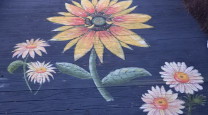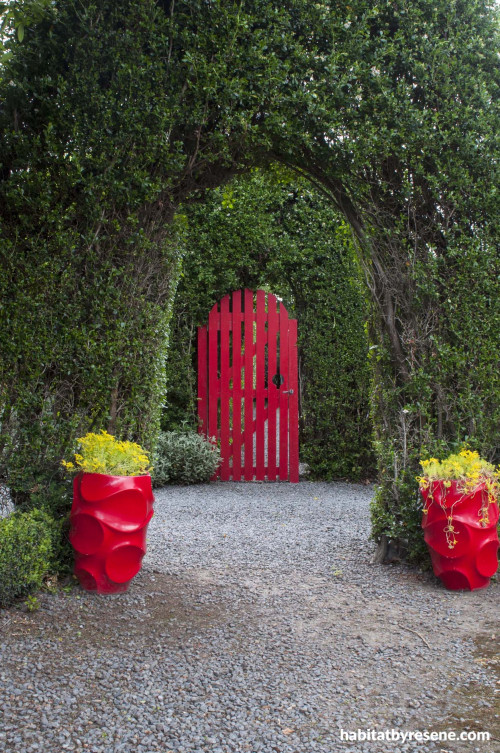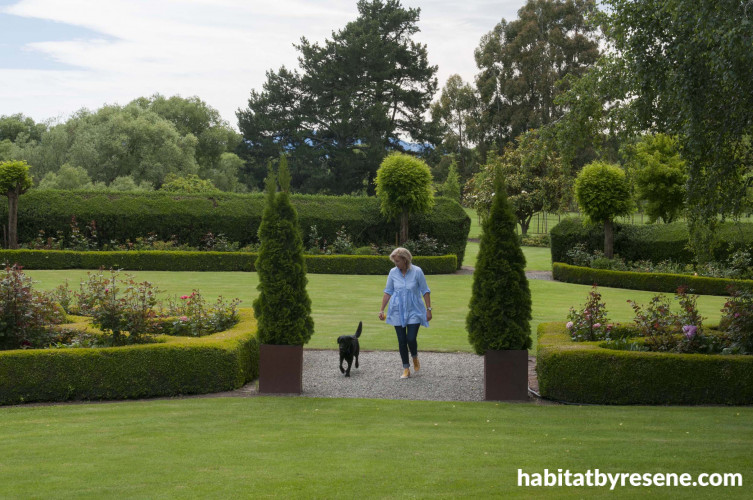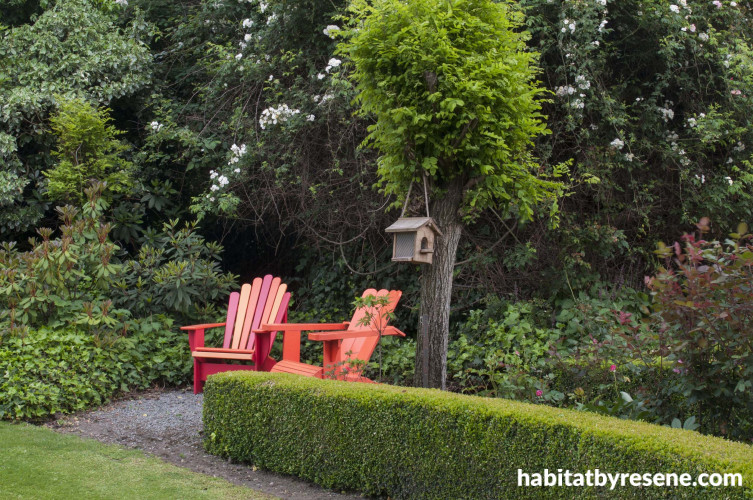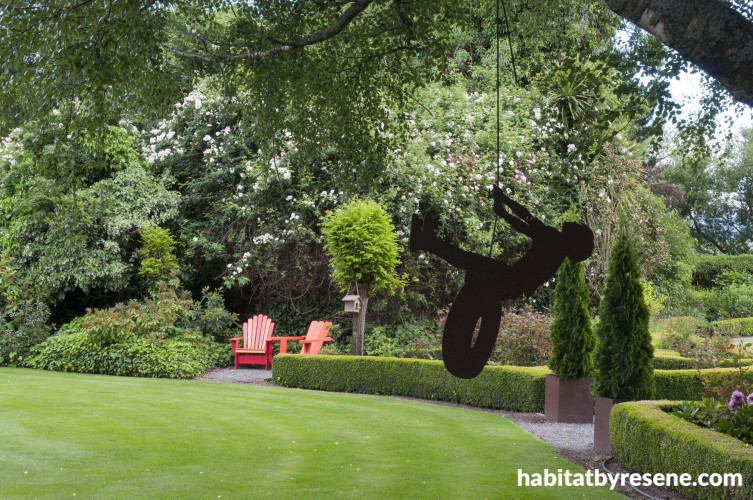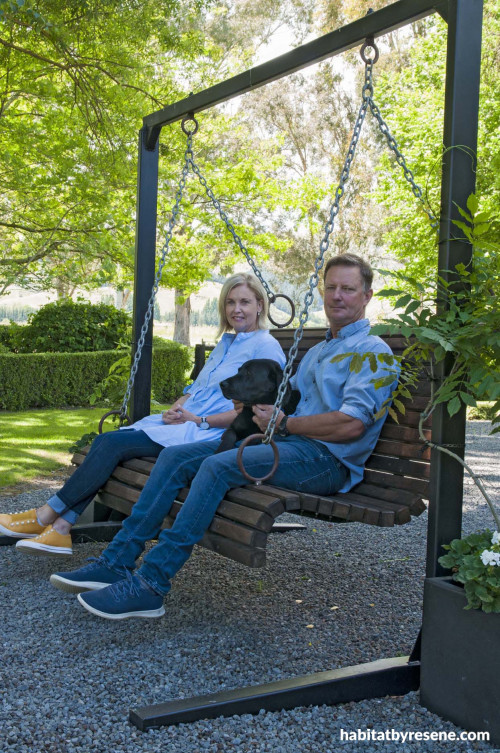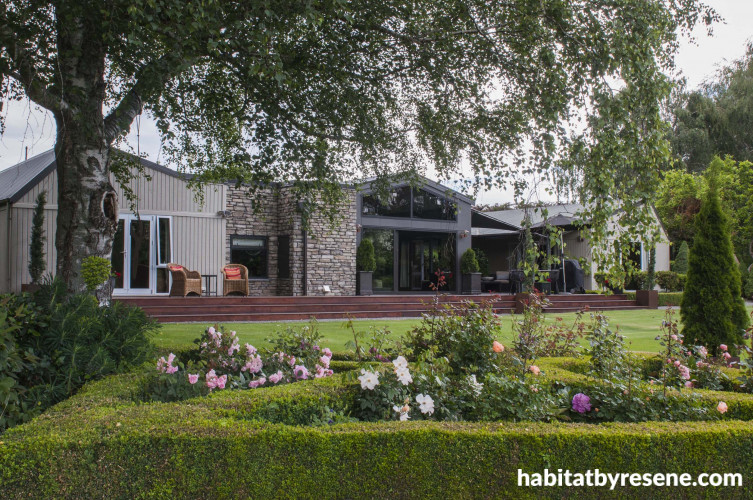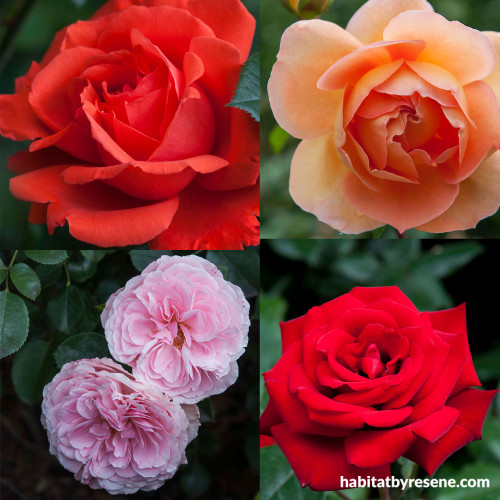A gate to remember: A garden that pops with colour in Hurunui
When Meg calls her Hurunui home a “do-up”, she just might be making the understatement of the year. When she and her husband, Tom, moved in 30 years ago, the house – then a little brown cottage – was so rundown, Meg felt as if the paint on the walls were the only thing holding the structure together. The windows were covered with masking tape to prevent the glass from blowing out thanks to the prevailing northwest wind. And the garden – what garden? – was just a bare paddock.
“It was a mess, but I was still so pleased to be there as I’d never had my own house before,” says Meg.
Three decades of hard yakka later, Meg and Tom’s home and garden are now a place in which the couple can unwind.
They took over the house and land, situated on one part of a larger family sheep and cattle farm, in 1991, when they were newlyweds. They had 11 boxes of clothes and possessions and no furniture. The “sad brown home” has since had a bold exterior colour change to Resene Napa and Resene Ironsand and was extended following the Kaikōura earthquake in 2016 after one side cracked in half. And the garden has been transformed from pony paddocks into a wonderland; roses, rhododendrons, natives and hedges are shaped into ‘rooms’, knot gardens, and archways. When Meg and Tom open their garden to the public at the Hurunui Garden Festival, visitors love to explore the grounds and see what’s behind the bold red Resene Poppy garden gate.
Meg didn’t set out to create a formal, structured garden – her green-fingered endeavours began as a distraction tactic. “We didn’t have a brass razoo to rub together. The house was run down when we moved in, and we couldn’t afford to change anything. I thought, ‘How can I deflect attention away from the house? I know, I’ll do a garden.’”
And so Meg, a self-taught gardener who grew up in central Sydney, mowed a circle in the paddock and created a lawn and border of perennial and annual flowers. As she was on a budget, she planted whatever she could “beg, borrow or steal” from friends.
In between her work as a rural business manager and raising her two sons Dan and Tim, now 24 and 27, Meg worked on the garden. Tom was too busy on the farm to be very involved and left Meg to it. But he was nervous every time she went out into the paddock – each time, the garden seemed to expand before his eyes.
The structural garden started taking shape 20 years ago once their children were a little older. Perennials that required constant dead-heading were switched for less-demanding roses and natives. The knot garden in front of the house was a bit of an experiment.
“When I first did the knot garden, it was a disaster. I didn’t know anything about using plumblines or creating a straight hedge, so they were as crooked as a dog’s hind legs. But as the hedges established, I carved them into something a bit straighter,” she says.
“I belong to a group on Facebook called NZ Gardening on a Budget. People say my garden doesn’t look like it was done on the cheap, but this is 30 years of budgeting and letting the garden evolve.”
Going against a senior member of the Hurunui Garden committee’s advice, Meg painted the gate beneath the escallonia arch in a bold red called Resene Poppy.
“The gardener said to me, ‘Oh no dear, I wouldn’t paint it that colour. I’d go more for maroon.’ But I don’t do maroon, I’m sorry.”
Tom constructed one of the Cape Cod chairs tucked into a corner of the front lawn, and their son Tim built the other chair in his woodwork class when he was at high school. Meg went for bold colours again, painting one chair in the punchy orange Resene Energise and the other in a cocktail of Resene Roadster, Resene Sorbus and Resene Energise.
“Before I painted them, Tim said, ‘Mum don’t go nuts with it, just paint it a nice white or a black.’ Of course, I didn’t listen. Instead, I painted the colours that remind me of a traffic-light ice-block.”
“Lo and behold, the new rhododendron I had just planted next to it came up in precisely those same colours – a happy accident.
“The chairs are great in winter when it’s snowing, and everything in the garden is monochrome because you have that burst of colour.”
The garden has a childlike sense of fun. A family friend built the outdoor swing and Tom built its structure, painted in Resene Ironsand to match the house’s exterior.
Artist Jane Downes’ metal sculpture of a little boy on a swing hangs from a silver birch tree planted in the 1960s. “That tree has always had swings, pinatas or tyres hanging from it. Now that my kids have grown up and left home, I needed a little boy playing in my garden again.”
The colourful flair has extended into her home. Meg chose rusty orange Resene Moroccan Spice for Dan’s bedroom and charcoal Resene Ironsand for the informal lounge area, which the family call the “snug”. She painted most of the house’s interior and exterior herself except for one occasion when a professional painted some repairs after the Kaikōura earthquake.
“I’ve never been afraid to try different shades – it’s only paint after all – and the family seems to enjoy the colour. They leave me to it. One time I struggled to reach the roof when painting the ceilings of our hallway but do you think one of my 6’ 2” sons would offer to give me a hand? They just walked past and said, ‘Don’t fall off the ladder, mum.’”
Meg’s favourite part of the house is the snug, which flows into the outdoor living area and decking, stained with Resene Kwila Timber Stain a few years ago.
“I love looking out at the lawn. It’s where there’s a lot of lovely family memories. I look at the garden and sometimes I can’t believe I’ve pulled it all off.”
Read more about Meg and Tom's home here. You can visit the Meg and Tom’s garden as part of the Hurunui Garden Festival. The annual festival is on the last weekend of October. For more info, visit www.hurunuigardenfestival.com
Rosy outlook
You need to be cruel to be kind with roses. Bushes will thank you after a heavy prune as it promotes flower growth and reduces disease. Midwinter, between June and mid-August, is the best time to pick up the secateurs. The idea is to encourage airflow and increase the light on the plant.
• Use sharp, clean secateurs and make all cuts at a 45º angle.
• Remove any dead-looking (brown) stems. Cut back dead stems to the stump.
• Cut back any spindly stems. Rose stems should ideally be the thickness of a ballpoint pen.
• Cut down green stems to the first outward-facing bud. A bud is a knob-like protrusion growing off the stem and it is where new growth comes from. Cut no more than 5mm above the bud on a 45º angle in the opposite direction of the bud.
• Don’t be afraid to remove large sections of the bush. Aim to cut back about a third of the plant and create a clear space near the rose’s centre to encourage airflow and prevent disease.
• With climbing roses, remove all dead branches and ensure ample support for training the plant in the summer – wooden trellis is ideal. Usually, climbing roses have one thick stem – don’t cut this too low as it might be slow to grow back.
Top tip: If you are using a dark exterior colour, remember to ask for the Resene CoolColour formula. It reflects more of the sun’s UV, protecting the paint and the cladding by minimising heat stress and potential damage.
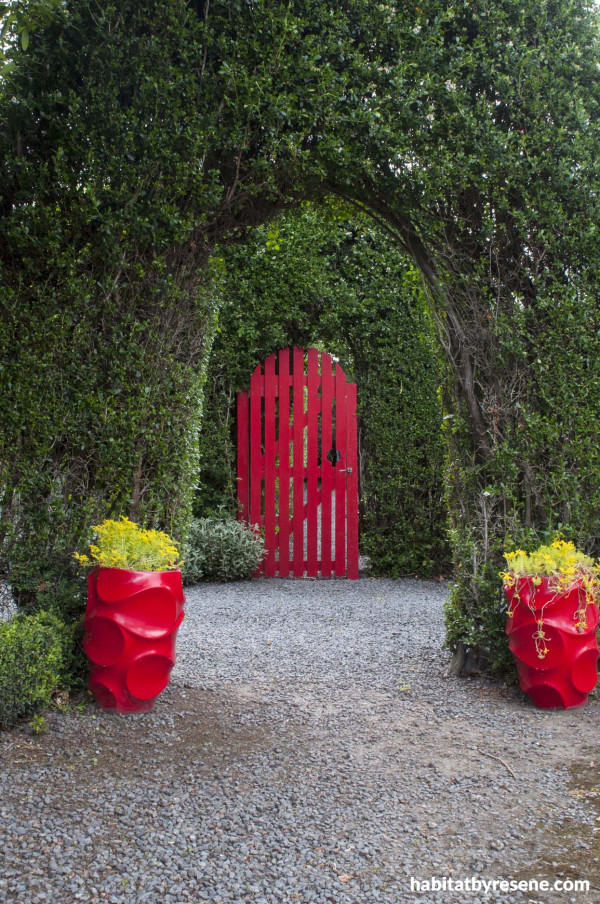
Meg’s striking gate in the escallonia hedge is painted in bold Resene Poppy to match two planters she already owned.
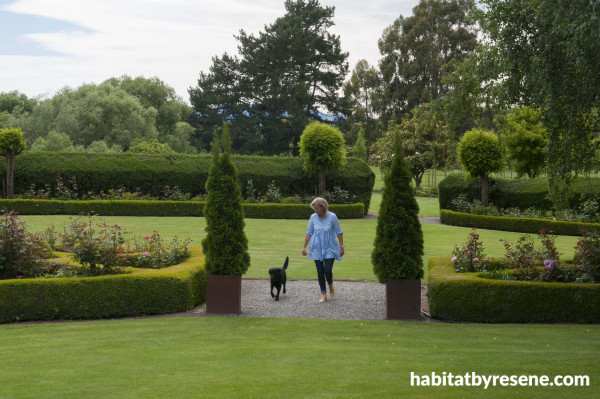
Meg’s garden has expanded during the 30 years she and Tom have been on the property. Tom made the steel planters at the entrance way which are planted with thujas. To give terracotta or wooden planters an aged steel look, paint with Resene FX Faux Rust Effect.
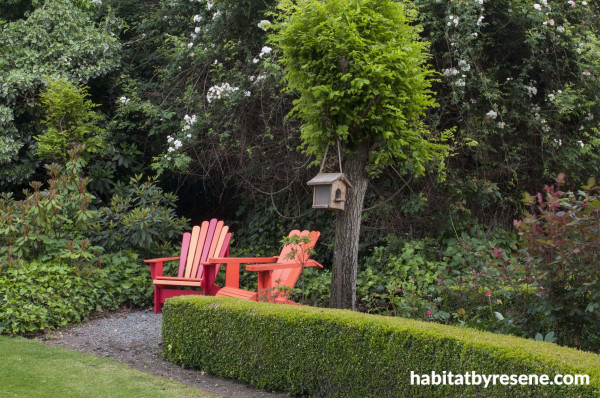
The Cape Cod chairs are a burst of colour in the front garden. The orange chair is Resene Energise and the multicolour chair is Resene Roadster, Resene Sorbus and Resene Energise.

A hanging sculpture by artist Jane Downes gives the garden a playful feel.
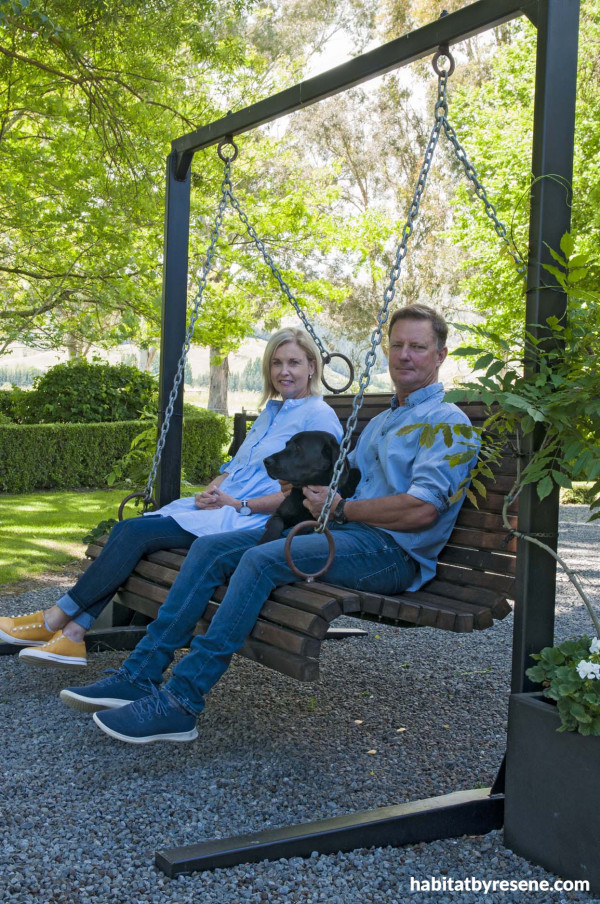
Meg, Tom and their dog Texas love to sit on the swing. A friend built the swing and seat and Tom built the stand which is painted in Resene Ironsand to match the home’s exterior.
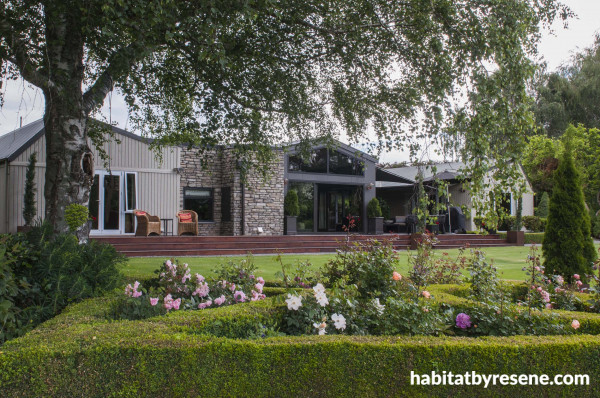
The exterior of the home in front of the knot garden is painted in Resene Ironsand on the extension and Resene Napa on the original home. The deck is protected using Resene Kwila Timber Stain. Remember to pick a slightly darker hue for your exterior than you would for your interior, as the sun will often make your colour choice look lighter.
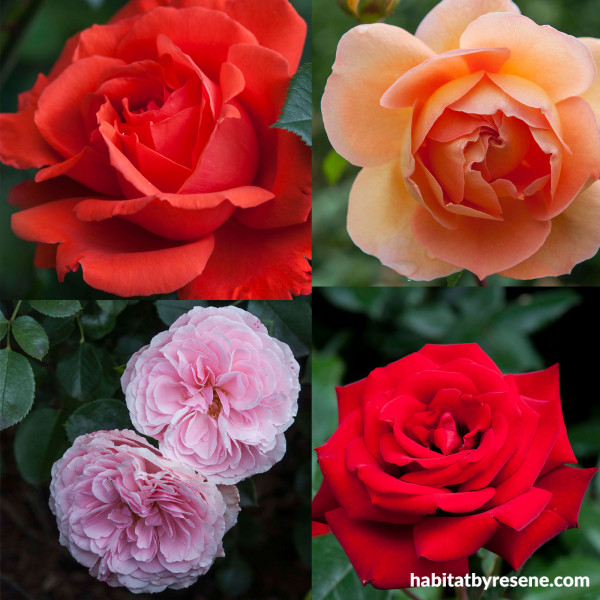
Meg’s rose garden has grown and grown over the years. Pictured clockwise from left ‘Alexander’, ‘Pat Austin’, ‘My Mum’ and ‘Love Heart’.
Published: 13 Aug 2021
Do you have a home full of wonderful Resene paint and colour? Send us some snaps by emailing [email protected].
the look
If you're stuck on what
colour to use or need colour
advice, try out the Resene
Ask a Colour Expert service.
the look
If you're stuck on what
colour to use or need colour
advice, try out the Resene
Ask a Colour Expert service.


